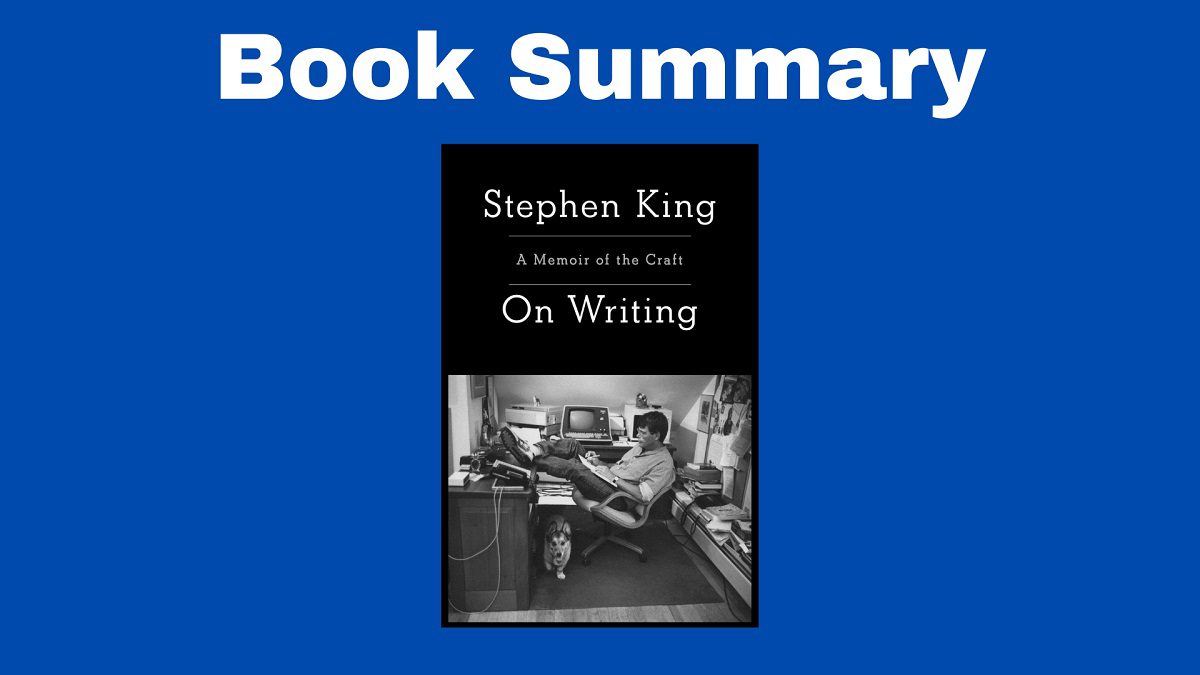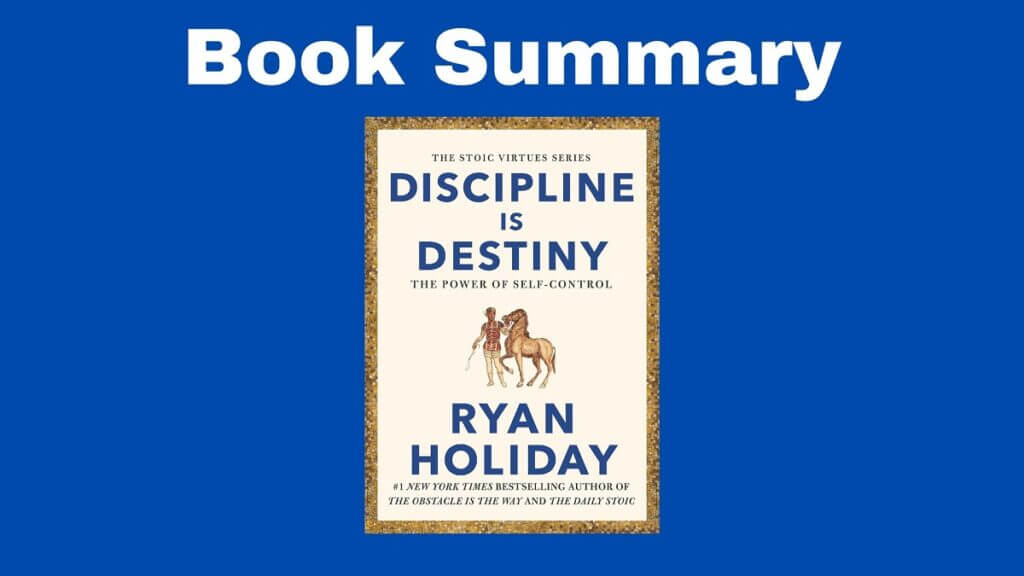The Book in Three Sentences
On Writing is divided into two: the first part is a memoir and the second part is a master class. In this summary of On Writing, you’ll learn how Stephen King became one of the most prolific writers of his generation. This is an essential book for writers and Stephen King fans.
On Writing Summary
Editor’s note: As the author points out at the beginning of the book, On Writing is divided into two parts: the first part is an autobiography and the second part is about the writing process. I don’t summarize autobiographies because those kinds of books rely on personal anecdotes and part of the fun of reading them involves the writer telling those stories in the first person. A lot is lost when an autobiography is turned into a summary which is why I ultimately decided not to include the first part of the book at all. Anyone remotely interested in reading this first part should track a copy of the book and do so. King eloquently explains events from his childhood in a relatable and honest manner.
The Toolbox
Books are portable magic. So King listens to the unabridged version of audiobooks and always carries a traditional book wherever he goes. Books are vital when you have to wait. His favorite place to read is in the blue chair in his study. According to King, the writer and reader are communicating telepathically. What the writer is writing, brings an image to the reader’s mind.
To be a good writer, you should build your own toolbox and carry it with you. You have most of the tools you need already. The most common tool goes on top and it’s vocabulary. Your vocabulary can be complex or simple but don’t make a conscious effort to improve it. Don’t look for long words. Don’t be ashamed of the short ones. Also, be plain and direct.
Grammar should also be at the top of your toolbox. If you don’t have a good grasp of grammar it’s too late because bad grammar produces bad sentences. Simple sentences combine a noun with a verb. Every writer has their own likes and dislikes. With active verbs, the subject of the sentence is doing something. With a passive verb, something is being done to the subject. Avoid using the passive tense. The passive voice is safe. The reader should always be your main concern. The adverb is not your friend. Adverbs are words that modify verbs, adjectives, and other adverbs. Adverbs and the passive voice tell us that a writer can’t express himself or herself clearly.
Underneath the top layer of the toolbox, where the vocabulary and the grammar sit, you can find other elements of style. The rule of possessives is the following: always add ‘s at the end of a word, even if the word you’re modifying ends in s. Then the author discusses paragraphs. Books that are easy to read have lots of short paragraphs, short lines of dialogue, and lots of white space. The objective of fiction is to make the reader feel welcome. The book’s length represents the commitment the author had when creating it. That said, long books aren’t always classic and short ones aren’t always bad.
On Writing
There are many bad writers, some competent writers, and a few good writers. Above them, you’ll find genius writers. Good writing is about mastering the fundamentals. It’s impossible to make a competent writer out of a bad one. It’s also impossible to make a great writer out of a good one. You can, with hard work, make a good writer out of a competent one.
To be a writer, you must read a lot and write a lot. King reads between seventy and eighty books a year. He doesn’t study the books he reads, he reads them because he loves to do so. Every book has a lesson you must learn, especially bad books. Good writing teaches style, narration, and plot development. We read to see the possibilities of what can be done and to experience different styles.
If you don’t have time to read, you don’t have the time or tools to become a writer. You can read everywhere and you can listen to audiobooks. Other distractions are the last thing an aspiring writer needs. If there’s no joy in reading and writing, you better find something better to do. When you find something you love, you can’t stop doing it because you’re happy. King suggests reading and writing for four to six hours a day.
This is King’s daily routine: mornings are for writing, afternoons are for naps and letters, and evenings are for reading, family, Red Sox games, and revisions. He doesn’t stop ongoing writing projects and doesn’t slow down. He writes every morning, otherwise, work feels like work. King tries to finish the first draft of a book in three weeks. The famous author writes ten pages a day or around 2,000 words. That amounts to 180,000 words over the course of three months. King’s secret to success is staying physically healthy and staying married.
The space where you write should be humble. It should only have one thing, a door that you can shut. This tells everyone you’re committed. King suggests that beginners write at least a thousand words a day, taking one day of the week off. Focus on writing one word at a time. Your office shouldn’t have a phone, TV, or video games. Curtains should be drawn. Eliminate all distractions. King writes with the loud music of AC/DC, Guns ‘n Roses, and Metallica. For him, music symbolizes another door that keeps everything out. It doesn’t matter what you write about as long as it’s the truth. Don’t write to impress anyone, don’t write to get money. Write what you like and give it life.
Stories and novels have three parts: narration, description, and dialogue. There’s no plot. Our plotless lives and the spontaneity of living are incompatible. Description begins in the writer’s imagination and ends in the reader’s. Avoid the description of the character’s wardrobe. The best description is that which features the first details you visualize. It’s not about the setting and it’s not about the characters, it’s about the story. Dialogue gives your character a voice. Never tell if you can show. You’re allowed to use foul language as long as you’re telling the truth. Most people, religious or not, use vulgar language. To say the contrary would be cowardly and dishonest. To achieve good storytelling, practice and honesty are indispensable. Every book is about something, every book has a theme.
Writers should work on two drafts and a polish. Beginner writers should work on two drafts, one with the study door close and one with the study door open. Write what you have in your head as fast as possible. This is to maintain enthusiasm and outrun the self-doubt. The first draft is written without any help. Refrain from showing it to someone else. When your first draft is complete, celebrate, show it to someone without discussing it, and rest for a few days. After resting, work on something shorter. Come back to your original book in around six weeks, when you come back, reread everything, and find holes and errors. You can then show it to people. Value the opinion of the person you write it for the most.
Pace refers to the speed at which the narrative unfolds. Each story should unfold at its own pace. Showing too much can bore your reader and a fast pace will lose people too. So find a happy medium that can satisfy your ideal reader. According to a letter King received after sending a story to a magazine: 2nd draft = 1st draft – 10%
The back story is what happened before your tale began and has an impact on the “front story”. The back story defines character and motivation. Remember that everyone has a story and most of it isn’t interesting, so focus on the parts that are. Sometimes you have to do research, but don’t forget that it belongs in the back. You’re writing a novel, not a research paper. The story comes first.




